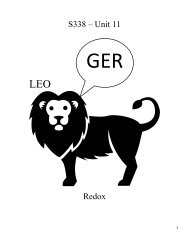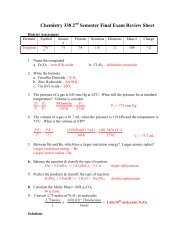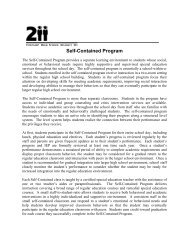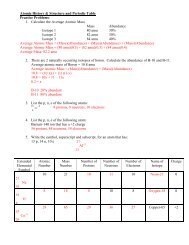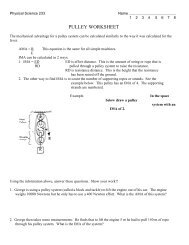Periodicity Type of Element
Periodicity Type of Element
Periodicity Type of Element
Create successful ePaper yourself
Turn your PDF publications into a flip-book with our unique Google optimized e-Paper software.
Pirate Chemistry<br />
<strong>Periodicity</strong><br />
The Periodic Table as it exists now gives a wealth <strong>of</strong> information to Chemists. Knowing how<br />
to interpret this information can make your life in Chemistry much easier.<br />
<strong>Type</strong> <strong>of</strong> <strong>Element</strong><br />
If we examine the table, we can see that it is broadly divided into three main sections by the<br />
heavy, black stairstep line. Those elements to the left <strong>of</strong> the stairstep line are metals. You can<br />
see by the table that the vast majority <strong>of</strong> all elements are metals.<br />
Metals generally:<br />
Are shiny<br />
Conduct electricity and heat<br />
Are malleable (can be hammered into thin sheets or foils)<br />
Are ductile (can be drawn into wires)<br />
Those elements to the right <strong>of</strong> the stairstep line are non-metals.<br />
Non-metals generally:<br />
Are dull-looking<br />
Don’t conduct heat or electricity well<br />
Are brittle as solids or are gases<br />
Those elements along the stairstep line are metalloids or semi-metals. They <strong>of</strong>ten have characteristics<br />
<strong>of</strong> both metals and non-metals. For instance, Silicon is shiny and conducts electricity<br />
like a metal but is brittle when hit with a hammer.<br />
Non-metals<br />
Metals<br />
Metalloids<br />
All text copyright Chris Smith 2009. All pictures obtained from internet and are copyright <strong>of</strong> their owners but assumed<br />
to be public accessible. If you are the owner <strong>of</strong> a picture and want it removed, email csmith@d211.org, and<br />
it will be.
Pirate Chemistry<br />
Sections <strong>of</strong> the Table<br />
You can also see that the table is broken into four major sections: the two tall columns on the<br />
left; the six tall columns on the right; the middle ten short columns; and the fourteen boxes removed<br />
from the table and placed at the bottom. Broadly speaking, the tall columns are called<br />
Main Group elements. They are columns 1, 2, and 13-18 or columns 1A through 8A (the A<br />
meaning a main group). These elements tend to follow trends and expectations fairly closely.<br />
The middle ten columns, 3 through 12 or 1B through 8B are called Transition Metals. Their<br />
chemistry can get a little tricky to predict so at this level we <strong>of</strong>ten ignore them. The two long<br />
rows at the bottom are called the Lanthanide and Actinide series. These elements are the<br />
strangest <strong>of</strong> all and we will be doing very little with them. The only reason these elements are<br />
at the bottom is so that the periodic table fits nicely on a sheet <strong>of</strong> paper. Examine the table at<br />
the bottom <strong>of</strong> the page for what the table really looks like!<br />
Main Group<br />
Transition Metals<br />
This is the extended periodic table. The Lanthanide<br />
and Actinide series are properly placed but it<br />
makes the table so wide, that it is <strong>of</strong>ten though to<br />
fit on a page!<br />
All text copyright Chris Smith 2009. All pictures obtained from internet and are copyright <strong>of</strong> their owners but assumed<br />
to be public accessible. If you are the owner <strong>of</strong> a picture and want it removed, email csmith@d211.org, and<br />
it will be.
Pirate Chemistry<br />
Groups or Families<br />
Look at any periodic table and you’ll notice that each vertical column on the table is labeled<br />
with a number and <strong>of</strong>ten a letter. This is to designate a group or family. A group or family on<br />
the periodic table are elements that are similar to each other. You probably resemble your family<br />
members in your physical and/or behavioral tendencies. This is not to say you are identical<br />
to your family, every person is unique, but whether you want to admit it or not, you are probably<br />
much like your family. The elements on the periodic table are the same way. Any element<br />
in the same column will most likely share many <strong>of</strong> the same qualities <strong>of</strong> the other elements in<br />
that column.<br />
Some families are so similar that they are given special names. These are the Noble Gases, the<br />
Alkali Metals, the Alkaline Earth Metals, and the Halogens. The Noble Gases (group 8A or<br />
18) are the elements in the very last column <strong>of</strong> the periodic table. They are called such because<br />
in ancient times the Noble families did not mix with the commoners. The Noble Gases do not<br />
react with any other element (unless under very unique circumstances) and thus cannot make<br />
compounds. The Alkali Metals (group 1A or 1) are the elements in the first column <strong>of</strong> the periodic<br />
table (Li, Na, K, Rb, Cs, Fr). They are all s<strong>of</strong>t, shiny metals that react violently with water<br />
to create a basic or alkali solution. The Alkaline Earth Metals (group 2A or 2) are the second<br />
column (Be, Mg, Ca, Sr, Ba). They are all metals that react with water to form an alkaline<br />
(basic) solution. They have a different valence than the alkali metals which sets them apart<br />
from them but that will be covered later. The Halogens (group 7A or 17) are the second to last<br />
column (F, Cl, Br, I). Halogen in Greek means salt forming and considering the most famous<br />
salt is table salt, sodium chloride (NaCl), it is easy to see why the family is named as such.<br />
Alkali Metals<br />
Noble Gases<br />
Alkaline Earth Metals<br />
Halogens<br />
All text copyright Chris Smith 2009. All pictures obtained from internet and are copyright <strong>of</strong> their owners but assumed<br />
to be public accessible. If you are the owner <strong>of</strong> a picture and want it removed, email csmith@d211.org, and<br />
it will be.
Pirate Chemistry<br />
Periods and Trends<br />
While the vertical columns on the table are called groups or families, the rows on the table are<br />
called periods. Each period represents a different energy level or shell <strong>of</strong> the electrons in the<br />
atom. Across each period from left to right there are a number <strong>of</strong> different trends <strong>of</strong> a variety <strong>of</strong><br />
physical and chemical properties <strong>of</strong> the elements. We will focus only on three.<br />
Atomic Radius<br />
Each atom is basically a tiny little sphere. The nucleus is at the center and the electrons orbit<br />
around the nucleus. Electrons from one atom repel the electrons <strong>of</strong> another atom (due to their<br />
same charge) and thus the size <strong>of</strong> the atom depends on the distance the outermost or valence<br />
electrons orbit. This distance from the nucleus to the valence electrons is called the atomic radius<br />
and it is different for each atom.<br />
Valence<br />
electrons<br />
Atomic Radius<br />
+<br />
Nucleus<br />
All text copyright Chris Smith 2009. All pictures obtained from internet and are copyright <strong>of</strong> their owners but assumed<br />
to be public accessible. If you are the owner <strong>of</strong> a picture and want it removed, email csmith@d211.org, and<br />
it will be.
http://www.avon-chemistry.com/p_table_atomic_rad.jpg<br />
Pirate Chemistry<br />
The sizes <strong>of</strong> the atoms are not random, though. There is an obvious trend if you examine the<br />
picture below:<br />
All text copyright Chris Smith 2009. All pictures obtained from internet and are copyright <strong>of</strong> their owners but assumed<br />
to be public accessible. If you are the owner <strong>of</strong> a picture and want it removed, email csmith@d211.org, and<br />
it will be.
Pirate Chemistry<br />
Let’s explain the trends. As we go down a column the atoms get bigger. There are two reasons<br />
for this. First, the valence electrons are getting further and further away from the nucleus at<br />
successively larger energy (n) levels.<br />
n=1<br />
n=2<br />
n=3<br />
n=4<br />
All text copyright Chris Smith 2009. All pictures obtained from internet and are copyright <strong>of</strong> their owners but assumed<br />
to be public accessible. If you are the owner <strong>of</strong> a picture and want it removed, email csmith@d211.org, and<br />
it will be.
Pirate Chemistry<br />
Second, as the valence electrons get further and further away, inner electrons prevent the positive<br />
nucleus from attracting the outer electrons in a process called shielding. The nucleus cannot<br />
exert as strong <strong>of</strong> a force on an outer electron when the inner electrons are getting in the<br />
way.<br />
Here the nucleus can efficiently attract the electrons as there is<br />
nothing between the nucleus and the them<br />
n=1<br />
Here the nucleus has three levels electrons in-between itself and<br />
the outermost (n=4) electrons. Levels 1-3 get in the way or<br />
“shield” the outermost electrons which reduces the ability <strong>of</strong> the<br />
nucleus to attract the electrons which allows them to fly further<br />
away and thus the size <strong>of</strong> the atom increases.<br />
n=4<br />
All text copyright Chris Smith 2009. All pictures obtained from internet and are copyright <strong>of</strong> their owners but assumed<br />
to be public accessible. If you are the owner <strong>of</strong> a picture and want it removed, email csmith@d211.org, and<br />
it will be.
Pirate Chemistry<br />
As you go from left to right across a row, however, the atoms get smaller. Why is that?<br />
First, because they are all in the same row, that means they are all at the same energy level.<br />
This means that each <strong>of</strong> these atoms have the same amount <strong>of</strong> shielding as each other. Second,<br />
as you go left to right the number <strong>of</strong> protons in the nucleus increases. This means that the nucleus<br />
has a greater amount <strong>of</strong> positive charge to attract the negative electrons. As you go down<br />
a column, the number <strong>of</strong> protons also increases but the shielding effect is obviously a greater<br />
influence which is why the size increases top to bottom.<br />
Ionic Size<br />
As atoms become ions their size changes in a predictable way. As metals lose electrons they<br />
drop to lower or inner energy levels and get a larger proton (positive) to electron (negative) ratio.<br />
This means that the positive effect <strong>of</strong> the nucleus is larger and therefore able to pull in the<br />
outer electrons more, decreasing the size <strong>of</strong> the ion. The opposite is true for non-metals. They<br />
gain electrons and thus effectively have fewer protons than electrons and therefore the nucleus<br />
cannot pull the valence electrons in as strongly and we see that the ions get bigger.<br />
As the ions get more positive, they get smaller. As the ions get more negative, they get bigger.<br />
All text copyright Chris Smith 2009. All pictures obtained from internet and are copyright <strong>of</strong> their owners but assumed<br />
to be public accessible. If you are the owner <strong>of</strong> a picture and want it removed, email csmith@d211.org, and<br />
it will be.
http://visual.merriam-webster.com/images/science/chemistry/matter/atom.jpg<br />
Pirate Chemistry<br />
Chart <strong>of</strong> Ionic Sizes<br />
Electronegativity<br />
Electronegativity is loosely defined as the relative attraction an atom has for electrons. For reasons<br />
we will get into later, metals want to give away electrons while non-metals want to gain<br />
electrons. Thus, metals tend to have low electronegativity values while non-metals tend to<br />
have high values. This is represented by the following table:<br />
You can see that the highest value is in the upper right, Fluorine, while the least is the lower<br />
left, Cesium. Generally speaking, electronegativity increases from left to right and decreases<br />
from top to bottom. Since Noble gases don’t react with anything there is no electron exchange<br />
so they have no electronegativities and are left <strong>of</strong>f the chart.<br />
All text copyright Chris Smith 2009. All pictures obtained from internet and are copyright <strong>of</strong> their owners but assumed<br />
to be public accessible. If you are the owner <strong>of</strong> a picture and want it removed, email csmith@d211.org, and<br />
it will be.
Pirate Chemistry<br />
Ionization Energy<br />
Ionization Energy is the amount <strong>of</strong> energy needed to remove an electron from an atom. Since<br />
non-metals want electrons, they tend to have high ionization energies. Since metals want to<br />
give up electrons, their ionization energies tend to be low. It is harder to remove an electron<br />
from a smaller atom due to the nucleus’ greater attraction for it. Thus, we see that ionization<br />
energy follows an inverse relationship to size. Larger atoms have valence electrons that are<br />
more shielded and thus easier to “pick <strong>of</strong>f”. With a few exceptions, the ionization energies increase<br />
from left to right and decrease from top to bottom.<br />
It is worth noting, however, that there are exceptions to this rule. We see that the B and O columns<br />
are less than they should be. Let’s see that in another form:<br />
All text copyright Chris Smith 2009. All pictures obtained from internet and are copyright <strong>of</strong> their owners but assumed<br />
to be public accessible. If you are the owner <strong>of</strong> a picture and want it removed, email csmith@d211.org, and<br />
it will be.
Pirate Chemistry<br />
B<br />
O<br />
Al<br />
S<br />
http://chemwiki.ucdavis.edu/Inorganic_Chemistry/Descriptive_Chemistry/Periodic_Table_<strong>of</strong>_the_<strong>Element</strong>s/Periodic_Trends<br />
We can explain this phenomenon easily by remembering Hund’s Rule: the most stable arrangement<br />
<strong>of</strong> electrons in an atom is when degenerate orbitals are half-filled spinning the same direction<br />
or totally filled. Let’s examine the orbital box notation <strong>of</strong> B and Al:<br />
B<br />
Al<br />
[He] 2s 2 2p 1<br />
[Ne] 3s 2 3p 1<br />
s<br />
p<br />
Each <strong>of</strong> these atoms has one lone electron in three<br />
possible orbitals. This is very unstable and thus B<br />
and Al will more easily lose this electron which<br />
results in a lower first-ionization energy.<br />
s p<br />
B +1<br />
Al +1 [Ne] 3s 2<br />
s<br />
p<br />
O [He] 2s 2 2p 4<br />
S [Ne] 3s 2 3p 4 s p<br />
O +1<br />
[He] 2s 2 2p 3<br />
[Ne] 3s 2 3p 3<br />
S +1 [He] 2s 2<br />
Here, the fourth electron is violating Hund’s Rule.<br />
If the atom gets rid <strong>of</strong> that electron, then it will<br />
have 3 identical orbitals all half-filled, spinning in<br />
the same direction. Thus, the first ionization energy<br />
is lower than expected.<br />
All text copyright Chris Smith 2009. All pictures obtained from internet and are copyright <strong>of</strong> their owners but assumed<br />
to be public accessible. If you are the owner <strong>of</strong> a picture and want it removed, email csmith@d211.org, and<br />
it will be.
Pirate Chemistry<br />
Additionally, we can explain ionization energy data past the first. IE 1 is the energy needed to<br />
remove the first electron from an atom. IE 2 is the energy needed to remove the second and so<br />
on. If we examine data for different atoms we see a trend:<br />
<strong>Element</strong> IE 1 IE 2 IE 3 IE 4<br />
Na 496 4562 6912 9543<br />
Why is there such a big jump after IE 1 ? Examine the spectroscopic notation:<br />
Na: [Ne] 3s 1<br />
Then remove the first electron with 496 kJ/mol<br />
Na +1 : [Ne]<br />
Now sodium has a Noble gas configuration and is stable. To remove another electron<br />
would violate this and so the IE 2 is much higher.<br />
What about Magnesium?<br />
<strong>Element</strong> IE 1 IE 2 IE 3 IE 4<br />
Mg 738 1451 7733 10,540<br />
The big jump here is after IE 2 . Why? Again, the spectroscopic notation:<br />
Mg: [Ne] 3s 2<br />
Then remove the first electron with 738 kJ/mol<br />
Mg +1 : [Ne] 3s 1<br />
Mg +1 does not have a Noble gas configuration yet. Remove electron 2 with 1451 kJ/mol<br />
(IE 2 is higher due to the electrons now being pulled in closer due to the positive charge<br />
but there still hasn’t been a huge jump yet).<br />
Mg +2 : [Ne]<br />
NOW magnesium has a Noble gas configuration and is stable. To remove the next electron<br />
would require a lot more energy due to the stable configuration.<br />
You basically see a big jump in Ionization energy after a Noble gas configuration is reached:<br />
<strong>Element</strong> IE 1 IE 2 IE 3 IE 4<br />
Na 496 4562 6912 9543<br />
Mg 738 1451 7733 10,540<br />
Al 578 1817 2745 11,577<br />
All text copyright Chris Smith 2009. All pictures obtained from internet and are copyright <strong>of</strong> their owners but assumed<br />
to be public accessible. If you are the owner <strong>of</strong> a picture and want it removed, email csmith@d211.org, and<br />
it will be.
Pirate Chemistry<br />
Electron Affinity<br />
Electron Affinity is the amount <strong>of</strong> energy involved when an electron is added to an atom. It is<br />
basically the opposite <strong>of</strong> ionization energy. However, the trend is the same as ionization energy<br />
because metals typically don’t want electrons and have a low electron affinity and non-metals<br />
want electrons so have a high affinity for electrons. Examine the chart below:<br />
This looks just like the ionization energy graph before except the exceptions are at different columns.<br />
All text copyright Chris Smith 2009. All pictures obtained from internet and are copyright <strong>of</strong> their owners but assumed<br />
to be public accessible. If you are the owner <strong>of</strong> a picture and want it removed, email csmith@d211.org, and<br />
it will be.
Pirate Chemistry<br />
Be<br />
Mg<br />
[He] 2s 2 2p 1<br />
[Ne] 3s 2 3p 1<br />
s<br />
p<br />
Trying to put an electron into this arrangement<br />
would be very unstable as it would violate Hund’s<br />
Rule again<br />
s p<br />
Be -1<br />
Mg -1 [Ne] 3s 2 3p 1<br />
s<br />
p<br />
N [He] 2s 2 2p 3<br />
P [Ne] 3s 2 3p 3 s p<br />
N -1<br />
[He] 2s 2 2p 4<br />
[Ne] 3s 2 3p 4<br />
P -1 [He] 2s 2 2p 1<br />
Here, the orbitals are half-filled spinning the same<br />
direction as so get extra stability from Hund’s<br />
Rule. Adding in an electron violates Hund’s rule<br />
and therefore has a lower-than-expected first Electron<br />
Affinity.<br />
All text copyright Chris Smith 2009. All pictures obtained from internet and are copyright <strong>of</strong> their owners but assumed<br />
to be public accessible. If you are the owner <strong>of</strong> a picture and want it removed, email csmith@d211.org, and<br />
it will be.






